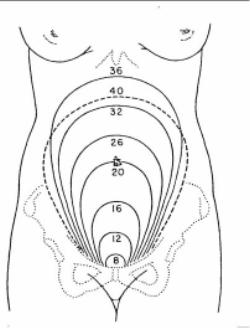This is the Archived Desktop Edition.
You should be transferred to the Newest Edition for Desktop and Mobile within 2 seconds.
|
Lesson 5: Physiologic Changes During Pregnancy
The changes that occur in the pregnant patient's body are caused by several factors. Many of these changes are the result of hormonal influence, some are caused by the growth of the fetus inside the uterus, and some are the result of the patient's physical adaptation to the changes that are occurring. This lesson is closely related to anatomy and physiology.
5-2. CHANGES OF THE REPRODUCTIVE SYSTEM DURING PREGNANCY
|
|
Changes in the body during pregnancy are most obvious in the organs of the reproductive system.
a. Uterus.
(1) Changes in the uterus are phenomenal. By the time the pregnancy has reached term, the uterus will have increased five times its normal size:
(a) In length from 6.5 to 32 cm.
(b) In depth from 2.5 to 22 cm.
(c) In width from 4 to 24 cm.
(d) In weight from 50 to 1000 grams.
(e) In thickness of the walls from 1 to 0.5 cm.
(2) The capacity of the uterus must expand to normally accommodate a seven-pound fetus and the placenta, the umbilical cord, 500 ml to 1000 ml of amniotic fluid, and the fetal membranes.
(3) The abdominal contents are displaced to the sides as the uterus grows in size, which allows for ample space for the uterus within the abdominal cavity.
(a) Growth of the uterus occurs at a steady, predictable pace.
(b) Measurement of the fundal height during pregnancy is an important factor that is noted and recorded (see figure 5-1).
(c) Growth that occurs too fast or too slow could be an indication of problems.
(d) The size of the uterus usually reaches its peak at 38 weeks gestation. The uterus may drop slightly as the fetal head settles into the pelvis, preparing for delivery. This dropping is referred to as "lightening." This is more noticeable in a primigravida than a multigravida.
NOTE
: Remember a primigravida is a woman pregnant for the first time. A multigravida is a woman who has been pregnant more than once.
b.
Cervix.(1) The cervix undergoes a marked softening which is referred to as the Goodell's sign."
(2) A mucus plug, which is known as "operculum" is formed in the cervical canal. This is the result of enlarged and active mucus glands of the cervix. It serves to seal the uterus and to protect the fetus and fetal membranes from infection. The mucus plug is expelled at the end of the pregnancy. This may occur at the onset of labor or precede labor by a few days. When the mucus is blood-tinged, it is referred to as a "bloody show."
(3) Additional changes and softening of the cervix occur prior to the beginning of labor.
c.
Vagina. Increased circulation to the vagina early in pregnancy changes the color from normal light pink to a purple hue which is known as the "Chadwick's sign."d.
Ovaries.(1) The follicle-stimulating hormone (FSH) ceases its activity due to the increased levels of estrogen and progesterone secreted by the ovaries and corpus luteum. The FSH prevents ovulation and menstruation.
(2) The corpus luteum enlarges during early pregnancy and may even form a cyst on the ovary. The corpus luteum produces progesterone to help maintain the lining of the endometrium in early pregnancy. It functions until about the 10th to 12th week of pregnancy when the placenta is capable of producing adequate amounts of progesterone and estrogen. It slowly decreases in size and function after the 10th to 12th week.
The Brookside Associates Medical Education Division is dedicated to the development and dissemination of medical information that may be useful to medical professionals and those in training to become medical professionals. This website is privately-held and not connected to any governmental agency. The views expressed here are those of the authors, and unless otherwise noted, do not necessarily reflect the views of the Brookside Associates, Ltd., any governmental or private organizations. All writings, discussions, and publications on this website are unclassified.
© 2007 Medical Education Division, Brookside Associates, Ltd. All rights reserved
